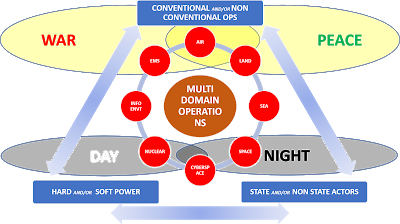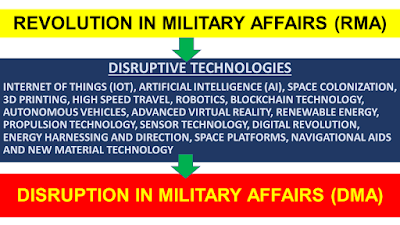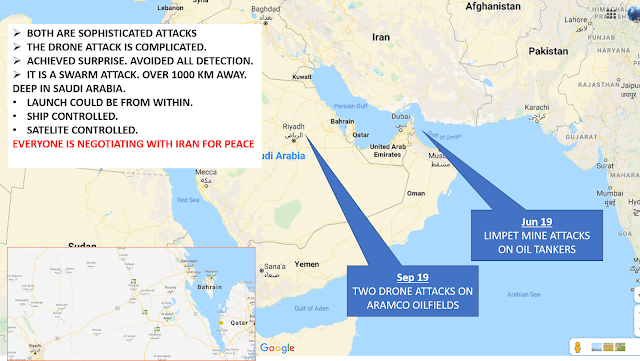
Preamble
This article has been motivated by “Imbalance of Power. India’s Military Choices in an Era of Strategic Competition with China” (https://www.cnas.org/publications/reports/imbalance-of-power) and “Do Generals Matter” (https://warontherocks.com/2019/06/do-generals-matter/) and War is Changing. Are We? (https://palepurshankar.blogspot.com/2019/10/war-is-changing-are-we-by-lt-gen-p-r.html) amongst others. However the real trigger for these thoughts is a conversation I had with a balanced and thinking military mind which conveyed to me.” The reasons for our anchorage to inertia need to be identified and addressed. Primarily, the Government and Armed Forces are not on the same page with respect to the threats and challenges. Further, Tri Service dissonance has resulted in lopsided capability development with no single authority taking ownership. Then, the intellectual quotient of our Generals needs to be qualitatively enhanced. The list is endless and shall be a long haul. But a beginning must be made”.

Introduction
Military Generals have often been accused of fighting tomorrow’s war with yesteryear experiences which will never occur in the future. Hitherto fore, they could get away with it since warfare was evolutionary. One could relate to the past and project it into the future without missing the woods for the trees. The much-touted Revolution in Military Affairs (RMA) revolutionised the weapon systems through technology but the battlefield remained confined to land, sea and air. That was the past. Tomorrow’s technologies are disrupting both the battlefield and weapon systems. That is why I call it Disruption in Military Affairs (DMA). The emerging multi domain battlefield is far different from the three- dimensional battlefield of the past. Flag officers of the yore were experts in one domain, could understand the other two domains reasonably well and could operate together in what was commonly known as “Joint Operations”. I sincerely think that era is over. Today’s flag officers (hereafter called Generals) must provide leadership in an enlarged battlefield with increasing levels of disruptive technologies.

When the battlefield itself is changing it is only axiomatic that Generalship needs to change as per the needs of Multi Domain Operations. However, in the Indian context, the challenge to all our Generals in green, white and blue is multifold. They must first, start thinking multi-domain. A new operational paradigm is emerging, and it needs a matching technological skill set. Generals must ensure the Armed Forces acquire weapons systems for tomorrow through the dysfunctional machinery of today which has not met even yesterday’s requirement. Lastly, there is no choice but to indigenise. No one is going to give us the technologies on the multi domain battlefield. Either we develop it, or we do not have it.

Operational Challenge
The biggest challenge facing our Generals is the necessity to see tomorrow’s battle contours. Take the case of the limpet mine attack on oil tankers in the Gulf and the UAV attacks on ARAMCO oilfields. Surgical, simultaneous, nonlinear, non-contact, offensive manoeuvre, op art – all boxes ticked. Tactical, operational and strategic outcomes were clear. Where is the scope for widespread Rommelesque tank battles, classic infantry bayonet charges, airforce eliminating counter air operations or sinking enemy destroyers through carrier strike groups when there is high degree of nuclear deterrence and economic/resource interdependence. Additionally, if the adversary is undertaking proxy war or using cyberspace or info space or the electromagnetic spectrum to get at you the dilemma is compounded. Examine all our military operations since the last two decades – Kargil War, surgical strikes of 2016, airstrikes of 2019 and Doklam. These probably represent the high and low end of the spectrum of employment of combat power in time, space and volume. They clearly indicate that wars we will have to fight have changed while we were still preparing for the last war. I am not propagating that you ignore the conventional, but our different coloured brass must smell the coffee. Unless we get our operational idea right, the rest does not have a meaning.
The days of declared or undeclared “war” are over. We have entered the age of constant conflict – 24x7x 365. Conflict through multiple domains – covert or overt – offensive or defensive. “wars” will be sporadic eruptions of violence in the conflict continuum. This is playing out. As India is rising it does not seek global domination or regional status. However, it is rising in a nuclear environment of a budding superpower on one side and a perpetually failing state on the other. Both inimical to India, aggressive and in collusion with each other, using every trick in the trade to stem its tide. Hence, we need an operational doctrine emanating from sagacious Generals who can think ahead of the oncoming curve.
Skill Set Challenge
The transition from RMA to DMA will be through a host of new technologies. Some have emerged and some still evolving. These technologies applied in Multiple Domains will define the future battlefield environment. Hence there is a need for our Generals to be up on speed on these subjects. Our Generals need to understand these wide range of subjects to do two things. One: to develop capabilities based on these technologies and two: to derive concepts and apply them on the Multi Domain Battleground. Very often the generalist General must take a decision on something he has no clue about. Often, he has been found disastrous in such situations. There is a second order effect. His Junior’s know and relate to these subjects better. When they find that their opinions being cast aside regularly without logic and cases made by them on solid technological premises are turned on their heads, a certain level of disaffection sets in. This enlarges into disrespect for Generals and other senior officers, which is growing healthier by the day. This transcends into other fields. The Senior – Junior divide is widening to weaken the leadership fabric of the Armed Forces. Further the third order effect is that the technically deficit generalist makes a weak case through his silence in forums which he should be dominating and guiding. As a result others (mainly bureaucracy) hijack the agenda and all is naught.
How many times have we heard Generals and officers saying that they are good fighters? They often proclaim to have spent their careers in CI ops and recount their numbers / kill-based operational performances with pride. They also mention that technology is not their domain and blame others for not developing weapons for them. This is all about weak one-dimensional skill sets. A CEO from the defence industry highlighted the classic case of the procurement of the basic infantry weapon – The Rifle. He pointed out that after seven decades India has not been able to develop its own Rifle. His question was that if Infantry Generals, who dominate the General Cadre and have garnered all high posts in the Army cannot develop a basic rifle for their own Arm-the Infantry, how can they be entrusted with preparing the Indian Army for the next generation battle with next generation technologies? It is time for each General irrespective of which hat or lanyard he wears, to be up to it or out of it. There is very little place to hide. The respective personnel branches of each Service must do some honest and soul-searching introspection regarding promotion and growth paths without the bias of lanyards or hats. Otherwise the Government will do it for them one day. There is too much mediocrity coming to the top based on the Regimental buddy system at the expense of professionalism. At the end I am clear on one thing – an ignorant below par General is a national disaster. There might be too many around too soon, I suspect
Process vs Outcomes Challenge
A new phenomenon is emerging. The Bureaucracy, the Researchers and Defence Industry (public and private) are now thanking the Armed Forces in Public Forums in supporting them in their efforts! I was shocked when I heard this repeatedly. When did they become the lead actors in the drama called “Conflict”? That too when their process driven system, constantly short on outcomes, has left the nation quite unprepared for the challenges it faces. While the “Dogmas of Delhi” remark by our external affairs ministers defines the challenge the nation faces, our Macro Military System is more disjointed than ever. The Indian Military System is facing “Dogmas Beyond Two Delhis”. Unless our Generals have the ability and courage of conviction to rise above peripheral issues and think strategically, to develop requisite capacities, we have a problem. Our military machinery which is a large and significant subset of the “Delhi Dogma” will not change unless our Generals can change their own Inter-service and Inter Corps “Dogmas” aided and abetted by a very strong and retrograde in house “military bureaucracy”. I respect Fd Marshal Manekshaw not for his operational ability in conduct of “War” but for his strategic ability to prepare the nation and the Armed Forces for “war” rising above all these “Dogmas” and “Bureaucracies”. He did so by a direct connect with the PM, even by passing the RM (Defence Minister), leave alone the bureaucracy, and giving a clear roadmap and preparing India for a successful blitzkrieg the world has never seen before or after. The day when India can listen to its Generals in the same breadth and is convinced of their apolitical view, professionalism, pragmatism, ability, knowledge and vision; that will be the day when the Indian Military Generals will be again respected. From then on, the rest will be QED.
Indigenisation Challenge
As Multi Domain Operations become the accepted norm, the need for technological enhancement will be greater. Having said that I will repeat what I often say – “Technology owned is cheap and technology bought is costly”. The days of heady economic growths are over. Even then defence budgets were contracting. Now a vicious cycle of a contracting defence budget of a contracting economic growth rate is looming ahead. This cycle will last half a decade at least. Defence technology required to combat new threats will get to be costlier to import as time passes. Our contracting defence budget is staring at an expanded battlefield. Eventually it will be “having less for more”. Unless we indigenise, we will be up the proverbial gum tree. Indigenisation will happen if Armed Forces lead the show. For that – our Generals need to be knowledgeable about technology, processes, operations, project management and administration and about putting many other things together to make indigenisation a success. We have models to follow – Navy in ship building and Artillery in Modernisation. Good generalship revolves around consolidation of what we have and building on it. Is it a tough ask? It seems to be since we are not learning from our successes and are predicted to be a top weapons importer for the next decade. Ultimately, I must say that passion and a degree of single mindedness must be brought in to achieve tangible indigenisation. Without passion, post retirement goodies can be realised but indigenisation will be a dream.
Conclusion
Multi Domain Operations are here to stay. Disruption in Military Affairs is happening. The operational environment is changing fast. Military Generals must gear up and provide a leadership of a different variety in future if they must safeguard our country. In the toxic and nuclear environment in which India finds itself, our military leadership needs greater dynamism. Our Generals, barring a few, have been far from inspirational in their leadership. That is because the system which produces these Generals is flawed to a large extent. Unless each Service introspects, there will be heavy price to pay beyond the “Delhi Dogma”. Generalship in Multi Domain Operations needs vision, pragmatism and sagacity to guide a sputtering system through a great change. This is going to be demanding. Are we up to it?
Postscript Comparison
Analyse the multiple unmanned aerial attacks on the Saudi oilfields at Khurais and Abuqaiq. It was a swarm attack more than 1000-1500 km away with weaponised UAVs. They had to be controlled from a Satellite, Aerial Relay or Ground Based Controllers near the targets. Requires a high degree of training and skill set. A very sophisticated attack planned by either Houthis or Iran. Both are not great military powers.
Can we do it? No, we cannot. Not for the next five years. Why? While we have strong Armed Forces, we do not have armed UAVs of that capability. All our operational UAVs are imported whose spares dependence is from abroad! Our efforts to develop indigenous UAVs have been floundering from one failure to another from the time I was a Lt Col till I retired as a Lt Gen. We do not have an alternate UAV development programme. We are desperately trying to import Predator type UAVs from US which will suck the oxygen out our defence budgets. In the meanwhile, the Army, Navy and Air Force Generals are having a merry squabble as to who should own the UAV empire. Of course, not to mention that Army has switched horses’ mid-stream as to who will manage their UAVs. Make it ten years. Multi Domain Capability – here I come through the Delhi Dogma.








